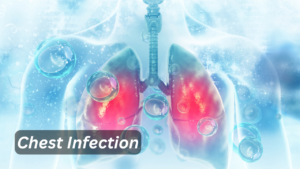
Chest infections, also known as lower respiratory
tract infections, are common respiratory illnesses
that can affect individuals of all ages. These
infections can be caused by a variety of
pathogens, including bacteria, viruses, and fungi.
In this blog post, we will discuss the symptoms,
diagnosis, treatment, and prevention of chest
infections.
Symptoms of Chest Infections:
Chest infections can present with a range of
symptoms, which may vary depending on the
underlying cause and severity of the infection.
Some common symptoms of chest infections
include:
1. Cough: A persistent cough is one of the
hallmark symptoms of a chest infection.
The cough may produce phlegm or mucus,
which can be clear, yellow, green, or bloody.
2. Chest pain: Chest pain or discomfort may
occur, especially when coughing or taking
deep breaths. The pain may be sharp or dull
and can worsen with movement.
3. Shortness of breath: Difficulty breathing,
wheezing, or a feeling of tightness in the
chest may be present in individuals with
chest infections.
4. Fever: An elevated body temperature is a
common sign of infection. Fever may be
accompanied by chills, sweating, and
general malaise.
5. Fatigue: Chest infections can cause fatigue,
weakness, and a lack of energy, making it
challenging to carry out daily activities.
6. Sore throat: Some individuals with chest
infections may experience a sore throat,
along with other upper respiratory
symptoms like nasal congestion.
7. Muscle aches: Muscle aches and body
aches are common symptoms of systemic
infection and inflammation.
Diagnosis of Chest Infections:
To diagnose a chest infection, your healthcare
provider will perform a thorough physical
examination and obtain a detailed medical
history. Diagnostic tests may be ordered to
confirm the presence of an infection and identify
the causative agent. Common diagnostic tests
for chest infections include:
1. Chest X-ray: A chest X-ray can provide
detailed images of the lungs, allowing
healthcare providers to assess for
abnormalities such as consolidations,
infiltrates, or fluid collections.
2. Sputum culture: A sample of sputum
(phlegm) may be collected and tested to
determine the type of pathogen causing the
infection, such as bacteria or fungi.
3. Blood tests: Blood tests, including a
complete blood count (CBC) and
inflammatory markers like C-reactive
protein (CRP) and erythrocyte
sedimentation rate (ESR), can help assess
the presence and severity of infection.
4. Microbiological tests: Depending on the
suspected pathogen, additional tests like
viral antigen testing, bacterial cultures, or
molecular diagnostics may be performed.
Treatment of Chest Infections:
Treatment for chest infections will vary based on
the causative agent and the severity of
symptoms. Common treatments for chest
infections include:
1. Antibiotics: Bacterial chest infections are
typically treated with antibiotics to target
and eliminate the bacterial pathogen. It is
essential to complete the full course of
antibiotics as prescribed by your healthcare
provider.
2. Antiviral medications: If the chest infection
is caused by a virus, antiviral medications
may be used in some cases.
3. Antifungal drugs: Fungal chest infections
may require treatment with antifungal
medications, such as fluconazole or
amphotericin B.
4. Bronchodilators: In cases of bronchospasm
or airflow limitation, bronchodilators like
albuterol may be used to help open up the
airways and improve breathing.
5. Supportive care: Adequate hydration, rest,
and over-the-counter medications for
symptom relief, such as cough
suppressants and pain relievers, may be
recommended.
6. Hospitalization: In severe cases of chest
infections, hospitalization may be
necessary for close monitoring, intravenous
antibiotics, oxygen therapy, or other
interventions.
Prevention of Chest Infections:
While it may not always be possible to prevent
chest infections entirely, there are steps you can
take to reduce your risk of contracting them:
1. Hand hygiene: Wash your hands frequently
with soap and water or use hand sanitizer to
prevent the spread of germs.
2. Avoid close contact: Limit exposure to
individuals who are sick, especially those
with respiratory symptoms like coughing or
sneezing.
3. Vaccinations: Stay up to date on
vaccinations, including the influenza (flu)
vaccine and the pneumococcal vaccine, to
protect against respiratory infections.
4. Healthy lifestyle: Maintain a healthy
immune system through regular exercise, a
balanced diet, adequate sleep, and stress
management.
5. Smoking cessation: Avoid smoking and
exposure to secondhand smoke, as
smoking irritates the respiratory tract and
weakens the immune system.
By incorporating these preventive measures into
your daily routine, you can reduce your risk of
developing a chest infection and support overall
respiratory health.
In conclusion, chest infections are common
respiratory illnesses that can cause a range of
symptoms, including cough, chest pain,
shortness of breath, fever, and fatigue. If you
experience symptoms of a chest infection, seek
medical attention promptly for a proper diagnosis
and treatment plan. By following preventive
measures such as hand hygiene, avoiding close
contact with sick individuals, staying up to date
on vaccinations, maintaining a healthy lifestyle,
and quitting smoking, you can lower your risk of
developing a chest infection and safeguard your
respiratory health. Remember that early
detection and timely intervention are key to
managing chest infections effectively. Stay
informed, stay vigilant, and prioritize your
respiratory well-being.